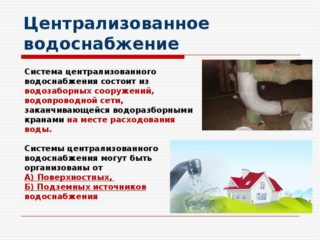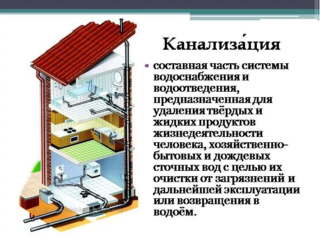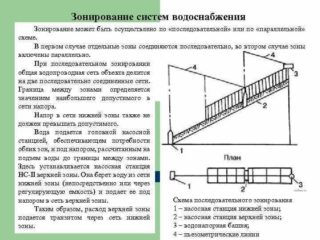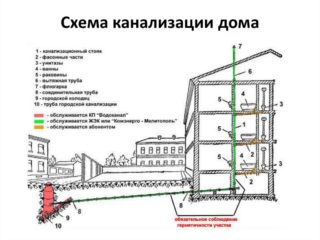Water is one of the main components of the ecosystem. The resource is constantly replenished, but human activity has a great influence on this process. That is why water supply and sewerage in Russia is strictly regulated and protected by law.
Definition and purpose of water supply and sewerage
The water supply system includes engineering structures that perform the following functions:
- water intake from rivers, lakes and springs;
- transportation and storage;
- distribution between homes and businesses;
- improvement of quality indicators.
Water disposal is equally important. This concept includes a set of measures for the reception of waste liquids from residential, industrial and economic facilities, purification and return to the natural environment. To exclude contamination of the ecosystem, a well-thought-out sewage system is required for collecting sewage, clarifying and disinfecting them.
Legislative regulation
To maintain water supply and drainage systems, enterprises must obtain a license, and employees must pass certification. This responsibility rests with all specialists responsible for design and construction work, as well as the operation of communication networks.
Licensing is necessary in order to streamline the work of housing and communal services, increase the operational level of engineering and technical facilities, and reduce to a minimum the risk of accidents and environmental problems due to the incompetence of communal workers and consumers.
Without a license, enterprises do not have the right to conclude agreements with the population on the provision of services related to cold and hot water supply and sanitation.
The relationship of the water supply and sewerage system
In the construction of new cities and towns, renovation and improvement, the design of water and sewerage highways is closely linked. This is a difficult job, because the installation scheme for water consumption and drainage systems must be planned even before the construction of the building foundations. And this applies to both internal and external networks.
If plumbing and sewerage pipelines are laid in erected houses, the process becomes more complicated. Exits are required to be created in finished walls, without disturbing their load-bearing qualities.
When installing and operating networks for the supply and drainage of liquids, it is imperative to comply with sanitary and building standards.They include the organization of security zones, the compliance of the supplied water with state standards and samples, the automation of labor-intensive processes and the use of modern technologies.
Types of water supply systems
For the smooth operation of water supply systems, many nuances must be taken into account. To organize the data, cold and hot water supply systems are divided into categories:
| Criterion | Types of plumbing |
| Type of objects served | railway, industrial, agricultural, urban, settlement |
| Water supply method | gravity, pressure and combined |
| Purpose | household and drinking, industrial, firefighter, combined |
| Territorial distribution | local, centralized, group, district |
| Method of sampling from a natural source | superficial, deep, mixed nutrition |
| The nature of the use of water | direct-flow with discharge into the sewer after use, direct-flow with repeated use of water, reverse with repeated use after cleaning and cooling. |
Each system is assigned one of three degrees of reliability. It depends on the requirements for uninterrupted water supply.
- Operating under pressure in an external water system. The most common and working in cases where the pressure at the inlet is greater than that required by the consumer.
- Equipped with a water tank. They are used with variable pressure in pipes.
- Equipped with a booster pump. They are necessary if the pressure at the inlet is lower than the required one, or there are too many water consumers.
- Equipped with both a booster and a water pressure device. Used when water consumption is uneven in a building.
In multi-storey buildings, water pipe zoning is practiced. In the lower zone, water is supplied due to the pressure from the external system, and on the upper floors - using pumping equipment. The size of each of the zones is determined by the maximum allowable hydrostatic head in the lowest section of the line.
The water supply connection always comes from a centralized network. In private cottages and summer cottages, water can come both from the central water system and from a local source - a well or a well.
Sewerage device
The main criteria for proper sewerage are: no unpleasant odor, excess moisture, smooth functioning without blockages and safety for people and the environment.
In apartment buildings, wastewater flows through an internal highway to a common riser. From there, the liquid flows by gravity into the centralized sewer network. The city storm drain directs its waters there. Additional treatment facilities are necessarily installed at industrial facilities.
Private sector buildings can also be connected to a city-wide or community-wide highway. There is a possibility of installing an individual treatment plant. An important point when planning a drainage scheme is choosing the right VOC.
The drainage and sewerage systems, working in parallel, provide comfortable living for people in high-rise and low-rise buildings. The operation of water supply and drainage systems is under strict legislative control. This is necessary to preserve human health and the safety of the ecosystem as a whole. Violation of standards, depending on the degree of severity, entails a fine and even criminal liability.












